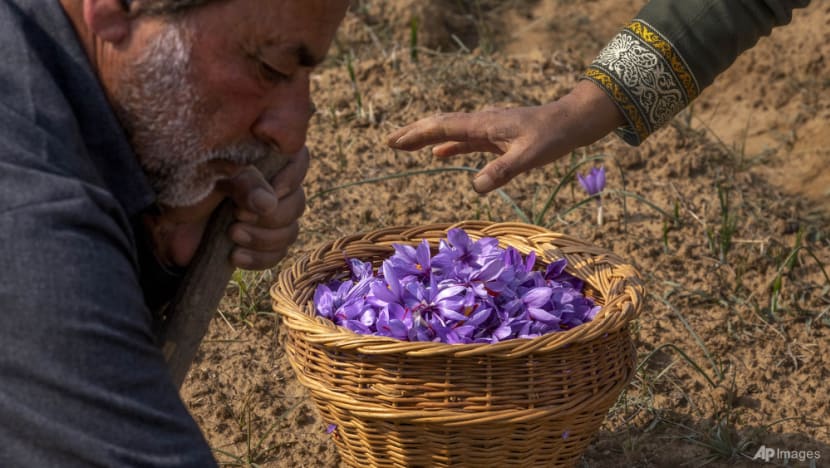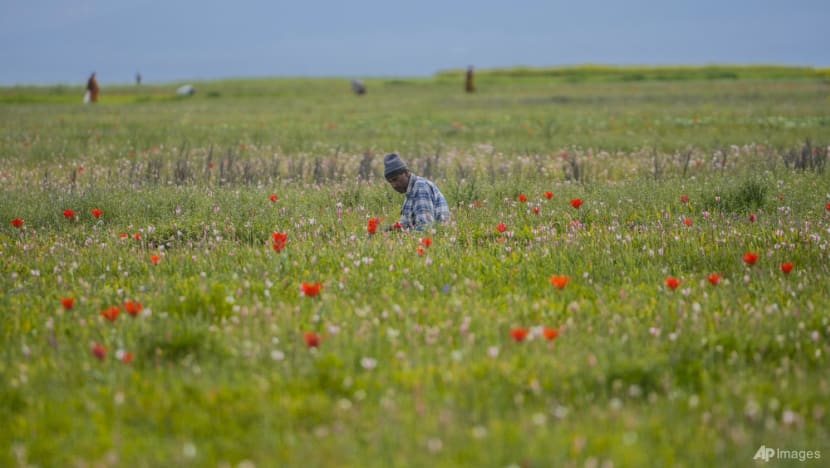Kashmir’s farmers revive saffron cultivation indoors as climate change hits
Production of the prized crimson spice in the region has withered more than 80 per cent in the past almost three decades, with the blame falling on insufficient rainfall and urbanisation.


This audio is generated by an AI tool.
PAMPORE: Farmer Irshad Ahmad Dar is worried about the future of his “red gold” crops in the town of Pampore, the heart of India’s saffron sector.
He makes his livelihood growing and selling saffron – the world’s most expensive spice – but crop yield in the Jammu and Kashmir region is facing a steep decline.
The bright purple flowers, which used to flourish in the area, have in recent years struggled to grow due to climate change and erratic weather conditions.
“The crop no longer receives timely and adequate rainfall necessary for its growth,” Irshad told CNA.
He sells his red-hued threads for US$4,600 per kilogram, higher than the global average.
The region boasts the priciest saffron in the world, with its quality – rich colour and intense aroma – giving it premium value.
KASHMIR’S RED GOLD
It takes 150,000 flowers to produce 1kg of saffron -- fragile strands of crimson and fragrant filaments laboriously picked by hand from saffron bulbs.
The spice is used in foods such as paella, as well as in fragrances, dye and medicine.
In India, the industry is estimated to be valued at about US$45 million.
Jammu and Kashmir produce about 90 per cent of India's saffron, of which a majority is grown in Pampore.
It is the third-largest saffron-producing region on the planet, after Iran and Afghanistan.
But Kashmir’s crops, already dwarfed by that of Iran’s which commands about 90 per cent of production worldwide, are dwindling even further.
Production has withered from nearly 16,000kg annually in 1997 to 2,600kg last year – a drop of more than 80 per cent.

Aside from global warming, fields cultivating the highly prized spice are also under threat from rapid urbanisation, and damaged by wild animals driven to farmlands by deforestation.
Indian authorities have vowed efforts to boost production.
BRINGING SAFFRON INDOORS
In 2018, scientists at the Sher-e-Kashmir University of Agricultural Sciences and Technology (SKUAST) tried to cultivate the crop in laboratory settings, using tubes containing moisture and vital nutrients.
It was hoped that bringing the crop under controlled conditions can alleviate the challenges of harsh weather elements and wild animals.
The experiment showed early promise across the sprouting, flowering and harvesting phases, and the method has been shared with traditional growers. However, farmers are struggling with propagation.
Bashir Ahmad Ellahi, lead researcher at SKUAST’s indoor farming experiment, said the project is still ongoing, and has shown that a controlled environment significantly reduces the risk of crop failure

In contrast, farmers in the state of Haryana – some 500km south of Kashmir – have reported more success.
"We created an artificial environment without using expensive equipment,” said indoor saffron cultivator Naveen Sindhu.
“(We) adopted low-cost heat sheets to control the temperature and installed an air conditioner, a chiller and a humidity controller.”

Naveen and his brother grow saffron in an indoor farm in the town of Hisar. They said they tasted success in their second attempt after learning from mistakes in the first failed batch.
They price their saffron at around US$6,300 per kilogram, earning more than US$23,000 a year.
The Indian government also has its sights set on transforming the northeast of the country into another saffron hub.
Since 2021, its Mission Saffron initiative has expanded farming across the states of Sikkim, Arunachal Pradesh, and Meghalaya, with plans to grow the spice even further.













